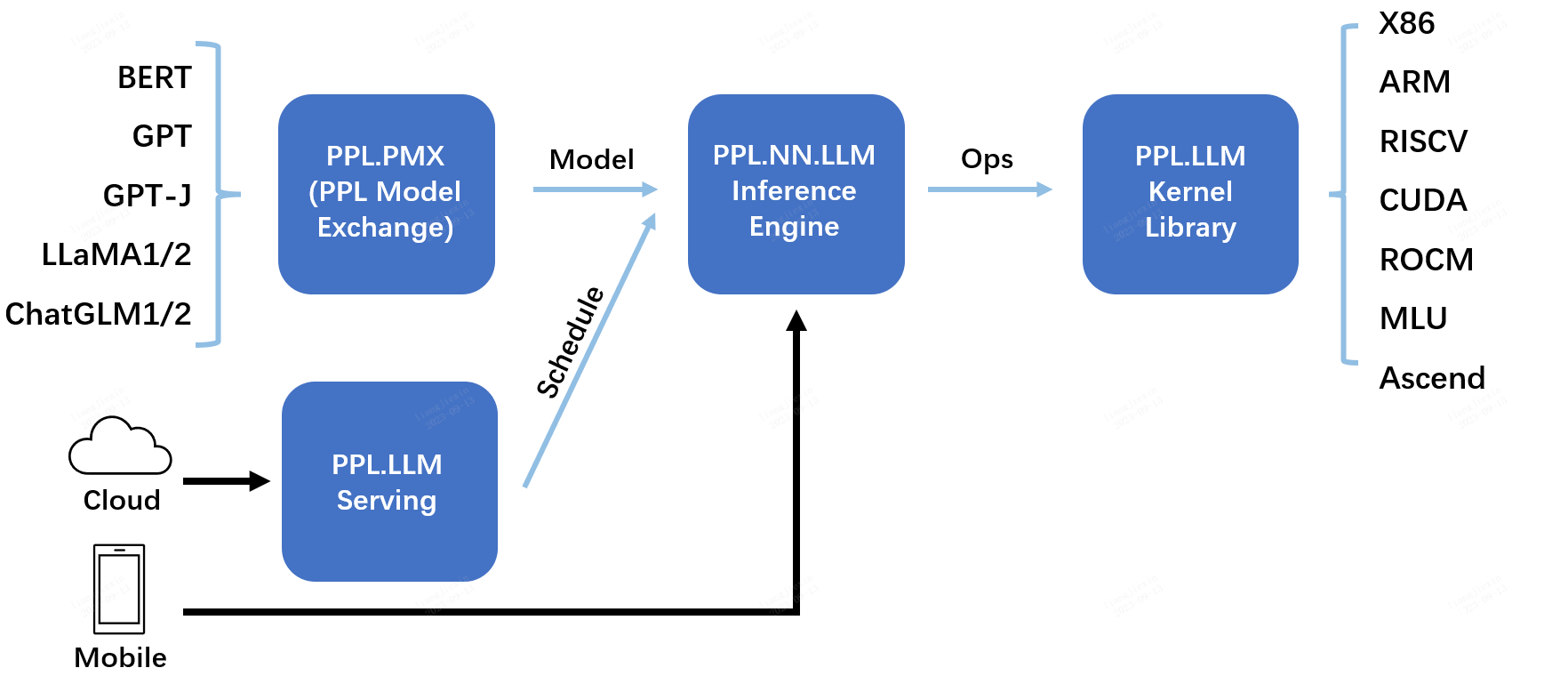ppl.nn.llm is a part of PPL.LLM system.
We recommend users who are new to this project to read the Overview of system.
ppl.nn.llm is a collection of Large Language Models(LLM) inferencing engines based on ppl.nn.
- Flash Attention
- Split-k Attention(Similar with Flash Decoding)
- Group-query Attention
- Dynamic Batching(Also called Continous Batching or In-flight Batching)
- Tensor Parallelism
- Graph Optimization
- INT8 groupwise KV Cache(Numerical accuracy is very close to FP16🚀)
- INT8 per token per channel Quantization(W8A8)
TBC
- NCCL issue on some Device: Currently reported that L40S and H800 may encounter illegal memory access on NCCL AllReduce. We suggest trying to turn NCCL protocol
Simpleoff by setting environmentNCCL_PROTO=^Simpleto fix this issue.
- Linux running on x86_64 or arm64 CPUs
- GCC >= 9.4.0
- CMake >= 3.18
- Git >= 2.7.0
- CUDA Toolkit >= 11.4. 11.6 recommended. (for CUDA)
- mpich >= 4.1.2 (when
PPLNN_CUDA_ENABLE_NCCL=ON)
- Installing prerequisites(on Debian 12 or Ubuntu 20.04 for example):
Cuda toolkit and mpich are recommended installing manually:
apt-get install build-essential cmake git- Cloning source code:
git clone https://github.com/openppl-public/ppl.nn.llm.git- Building from source:
For nvidia ampere architecture we should use sm80, sm86 and sm87.
cd ppl.nn.llm
./build.sh -DPPLNN_USE_LLM_CUDA=ON -DPPLNN_CUDA_ENABLE_NCCL=ON -DPPLNN_ENABLE_CUDA_JIT=OFF -DPPLNN_CUDA_ARCHITECTURES="'80;86;87'" -DPPLCOMMON_CUDA_ARCHITECTURES="'80;86;87'"- Export a model(such as LLaMA) and dump some tensors for testing:
Refer to ppl.pmx/model_zoo/llama/facebook/README.md
- Build a bash script
benchmark.shfor testing as below(this example is only for dynamic batching model):
if [ ! -n "$MPI_LOCALRANKID" ]; then
echo "[WARNING] MPI_LOCALRANKID not found, set to 0"
MPI_LOCALRANKID=0
fi
DEVICE_ID=$MPI_LOCALRANKID
STEP=$1
if [ ! -n "$STEP" ]; then
STEP=0
fi
MODEL_PATH="/path/to/exported/model/model_slice_${MPI_LOCALRANKID}/model.onnx"
OUTPUT_DIR="/path/to/output_dir/rank_${MPI_LOCALRANKID}" # we should make the rank_* directories first
TEST_DATA_DIR="/path/to/dumped/tensor/data/rank_${MPI_LOCALRANKID}"
# we should rearrange the input tensors if the model exporting parameters has been changed.
TOKEN_IDS=`ls ${TEST_DATA_DIR}/step${STEP}_token_ids-*`
ATTN_MASK=`ls ${TEST_DATA_DIR}/step${STEP}_attn_mask-*`
SEQSTARTS=`ls ${TEST_DATA_DIR}/step${STEP}_seqstarts-*`
KVSTARTS=`ls ${TEST_DATA_DIR}/step${STEP}_kvstarts-*`
CACHESTARTS=`ls ${TEST_DATA_DIR}/step${STEP}_cachestarts-*`
DECODING_BATCHES=`ls ${TEST_DATA_DIR}/step${STEP}_decoding_batches-*`
START_POS=`ls ${TEST_DATA_DIR}/step${STEP}_start_pos-*`
MAX_SEQLEN=`ls ${TEST_DATA_DIR}/step${STEP}_max_seqlen-*`
MAX_KVLEN=`ls ${TEST_DATA_DIR}/step${STEP}_max_kvlen-*`
KV_CAHCE=`ls ${TEST_DATA_DIR}/step${STEP}_kv_cache-*`
KV_SCALE=`ls ${TEST_DATA_DIR}/step${STEP}_kv_scale-*`
TEST_INPUTS="$TOKEN_IDS,$ATTN_MASK,$SEQSTARTS,$KVSTARTS,$CACHESTARTS,$DECODING_BATCHES,$START_POS,$MAX_SEQLEN,$MAX_KVLEN,$KV_CAHCE,$KV_SCALE"
INPUT_DEVICES="device,device,device,device,device,host,device,host,host,device,device"
CMD="~/path/to/pplnn-build/tools/pplnn_llm --use-llm-cuda \
--onnx-model $MODEL_PATH \
--shaped-input-files $TEST_INPUTS \
--save-outputs \
--device-id $DEVICE_ID \
--save-data-dir $OUTPUT_DIR \
--in-devices $INPUT_DEVICES \
--enable-profiling \
--min-profiling-seconds 3 \
--warmup-iterations 10"
echo "RUN RANK${MPI_LOCALRANKID} STEP${STEP} -> $CMD"
eval "$CMD"- Run
benchmark.shwithmpirun
mpirun -np <MP> benchmark.sh <STEP>
The MP value for LLaMA can be found Here.
build with -DPPLNN_ENABLE_PYTHON_API=ON (use sm80, sm86 and sm87 in this example):
cd ppl.nn.llm
./build.sh -DPPLNN_USE_LLM_CUDA=ON -DPPLNN_CUDA_ENABLE_NCCL=ON -DPPLNN_ENABLE_CUDA_JIT=OFF -DPPLNN_CUDA_ARCHITECTURES="'80;86;87'" -DPPLCOMMON_CUDA_ARCHITECTURES="'80;86;87'" -DPPLNN_ENABLE_PYTHON_API=ONand test:
PYTHONPATH=./pplnn-build/install/lib python3 tools/pplnn_llm.py --use-llm-cuda --onnx-model </path/to/model.onnx>Building a benchmark test for LLaMA model with full generation steps. The difference with previous benchmark, is that previous one benchmark with one step, while here benchmark for whole generation steps. Refer to tools/benchmark.sh for more detail.
~/ppl.nn.llm/pplnn-build/tools/benchmark_llama \
--model_type $MODEL_TYPE \
--model_dir $MODEL_DIR \
--model_param_path $MODEL_PARAM_PATH \
--tensor_parallel_size $TENSOR_PARALLEL_SIZE \
--top_p $TOP_P \
--top_k $TOP_K \
--temperature $TEMPERATURE \
--warmup_loops $WARMUP_LOOPS \
--generation_len $GENERATION_LEN \
--benchmark_loops $BENCHMARK_LOOPS \
--input-len $INPUT_LEN \
--batch_size $BATCH_SIZE \
--quant-method $QUANT_METHOD
Input parameter explains:
-
model-type: basic type of model, including diffenent weight. For example, model typellamaincluding llama-7b, llama-13b, llama-30b and llama-65b. For other llm model, we will support soon. -
model_dir: path to the model. -
model_param_path: path to model params. -
tensor_parallel_size: size of tensor parallel. For llama_7b, the value is 1. -
top_p: select enough tokens to "cover" a certain amount of probability defined by the parameter p (refer to Token selection strategies: Top-K, Top-p, and Temperature for more detail). The value range from 0~1. -
top_k: select the first top k tokens to create new distribution (refer to Token selection strategies: Top-K, Top-p, and Temperature for more detail). This value does not matter on current version. -
temperature: Temperature affects how “random” the model’s output is (refer to Token selection strategies: Top-K, Top-p, and Temperature for more detail). -
warmup_loops: loops to warm up GPU for accurate performance. -
generation_len: length of generated tokens. -
benchmark_loops: benchmark loops. -
input_len: length of input tokens, default is zero. -
input_file: file of input tokens, not use ifinput_lenis non-zero. -
batch_size: batch size. -
quant_method: only accept two value: {none,online_i8i8}.nonemeans not quantize, andonline_i8i8(also calledw8a8) means weight and tensor are both quantized with int8.
Notice: we found that nsys profiler do not trace cuda kernel statisic in nccl multi-thread communication mode. If you want to profile with nsys, pleace compile with PPLNN_CUDA_ENABLE_NCCL=OFF, and it could only trace the performance in one card model.
./build.sh -DPPLNN_USE_LLM_CUDA=ON -DPPLNN_CUDA_ENABLE_NCCL=OFF -DPPLNN_ENABLE_CUDA_JIT=OFF -DPPLNN_CUDA_ARCHITECTURES="'80;86;87'" -DPPLCOMMON_CUDA_ARCHITECTURES="'80;86;87'"Tested under base clock in 12/2023
| Model | Batch | TP | Input Length | Output Length | Throughput (out tok/s) |
|---|---|---|---|---|---|
| LLaMA 7B | 1 | 1 | 8 | 256 | 85.5 |
| LLaMA 7B | 256 | 1 | 8 | 256 | 8933.3 |
| LLaMA 7B | 1 | 1 | 1024 | 1024 | 82.4 |
| LLaMA 7B | 32 | 1 | 1024 | 1024 | 1247.9 |
| LLaMA 13B | 1 | 2 | 8 | 256 | 76.1 |
| LLaMA 13B | 384 | 2 | 8 | 256 | 8393.0 |
| LLaMA 13B | 1 | 2 | 1024 | 1024 | 73.8 |
| LLaMA 13B | 32 | 2 | 1024 | 1024 | 1199.7 |
| LLaMA 70B | 1 | 8 | 8 | 256 | 42.5 |
| LLaMA 70B | 1024 | 8 | 8 | 256 | 6872.7 |
| LLaMA 70B | 1 | 8 | 1024 | 1024 | 41.3 |
| LLaMA 70B | 128 | 8 | 1024 | 1024 | 1930.7 |
Refer to ppl.pmx for how to export onnx models. Refer to APIs in documents of ppl.nn.
This project is distributed under the Apache License, Version 2.0.
